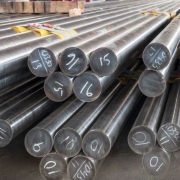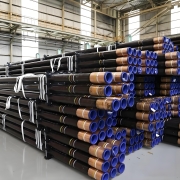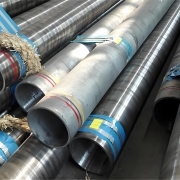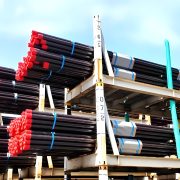All You Need to Know: Super 13Cr
1. Introduction and Overview
Super 13Cr is a martensitic stainless steel alloy known for its exceptional mechanical strength and moderate corrosion resistance, making it ideal for demanding environments. Originally developed for oil and gas applications, Super 13Cr offers a cost-effective alternative to higher alloyed materials, especially in moderately corrosive environments where chloride-induced stress corrosion cracking (SCC) is a concern.
Due to its enhanced mechanical properties and improved corrosion resistance compared to conventional 13Cr stainless steel, Super 13Cr is widely used in industries like oil and gas, chemical processing, pulp and paper, marine and offshore, air pollution control, and power generation.
2. Available Super 13Cr Products and Specifications
Super 13Cr is available in a variety of forms to meet diverse application requirements:
- UNS Number: S41426
- Common Name: Super 13Cr
- W.Nr.: 1.4009
- ASTM/ASME Standards: ASTM A276, A479, A182
- Product Forms: Pipe, Tube, Bar, Rod, Forging Stock
3. Applications of Super 13Cr
Super 13Cr’s combination of strength, hardness, and corrosion resistance makes it suitable for various applications:
- Oil and Gas: Tubing, casing, and pipelines in mildly corrosive environments with CO₂ and limited H₂S exposure.
- Chemical Processing: Equipment and piping systems handling moderately aggressive chemicals.
- Pulp and Paper: Components exposed to harsh chemical processing environments.
- Marine and Offshore: Components in seawater handling, including pumps, valves, and other marine structures.
- Power Generation: Steam turbine blades and components are exposed to high temperatures and corrosion.
- Air Pollution Control: Components exposed to aggressive flue gases and acidic environments.
- Food Processing: Equipment used in environments where hygiene and corrosion resistance are critical.
- High-Efficiency Residential Furnaces: Heat exchangers due to the material’s durability under high temperatures.
4. Corrosion Resistance Properties
Super 13Cr offers better corrosion resistance than conventional 13Cr stainless steel, particularly in environments containing CO₂. However, it is not suitable for environments with significant H₂S content due to the risk of sulfide stress cracking. The alloy provides good pitting and crevice corrosion resistance in chloride-containing environments and is resistant to stress corrosion cracking under moderate chloride concentrations.
5. Physical and Thermal Properties
- Density: 7.7 g/cm³
- Melting Range: 1,400–1,450°C
- Thermal Conductivity: 25 W/mK at 20°C
- Specific Heat: 460 J/kg·K
- Thermal Expansion Coefficient: 10.3 x 10⁻⁶/°C (20–100°C)
6. Chemical Composition
Typical chemical composition of Super 13Cr includes:
- Chromium (Cr): 12.0–14.0%
- Nickel (Ni): 3.5–5.5%
- Molybdenum (Mo): 1.5–2.5%
- Carbon (C): ≤0.03%
- Manganese (Mn): ≤1.0%
- Silicon (Si): ≤1.0%
- Phosphorus (P): ≤0.04%
- Sulfur (S): ≤0.03%
- Iron (Fe): Balance
7. Mechanical Properties
- Tensile Strength: 690–930 MPa
- Yield Strength: 550–650 MPa
- Elongation: ≥20%
- Hardness: 250–320 HB
- Impact Toughness: Excellent, especially after heat treatment.
8. Heat Treatment
Super 13Cr is typically hardened through heat treatment to improve its mechanical properties. The heat treatment process involves quenching and tempering to achieve the desired combination of strength and toughness. The typical heat treatment cycle includes:
- Solution Annealing: Heating to 950–1050°C, followed by rapid cooling.
- Tempering: Reheating to 600–700°C to adjust hardness and toughness.
9. Forming
Super 13Cr can be hot or cold-formed, although it is more challenging to form than austenitic grades due to its higher strength and lower ductility. Preheating before forming and post-forming heat treatments are often necessary to avoid cracking.
10. Welding
Welding Super 13Cr requires careful control to avoid cracking and maintain corrosion resistance. Preheat and post-weld heat treatment (PWHT) are typically required. Filler materials should be compatible with Super 13Cr to ensure weld quality. Special care must be taken to avoid hydrogen embrittlement.
11. Corrosion of Welds
Welds in Super 13Cr can be susceptible to localized corrosion, particularly in the heat-affected zone (HAZ). Post-weld heat treatment is critical to restore corrosion resistance, reduce residual stresses, and improve toughness in the welded area.
12. Descaling, Pickling, and Cleaning
Descaling of Super 13Cr can be challenging due to the formation of a tough oxide scale during heat treatment. Mechanical methods like blasting or chemical treatments using pickling solutions can be employed to remove scale. The alloy requires thorough cleaning after pickling to avoid contamination and ensure optimal corrosion resistance.
13. Surface Hardening
Super 13Cr can undergo surface hardening treatments like nitriding to enhance its wear resistance without compromising its corrosion resistance. Nitriding helps improve the alloy’s durability in abrasive and high-friction environments.
Conclusion
Super 13Cr offers a versatile solution for industries where moderate corrosion resistance and high mechanical strength are required. Its balanced properties make it a popular choice in oil and gas, chemical processing, and marine applications, among others. By understanding its unique characteristics—from corrosion resistance to weldability—engineers and materials specialists can make informed decisions to optimize performance and longevity in their specific environments.
This blog post provides a comprehensive overview of Super 13Cr’s specifications and properties, equipping industries with the knowledge to make the best use of this advanced material.





